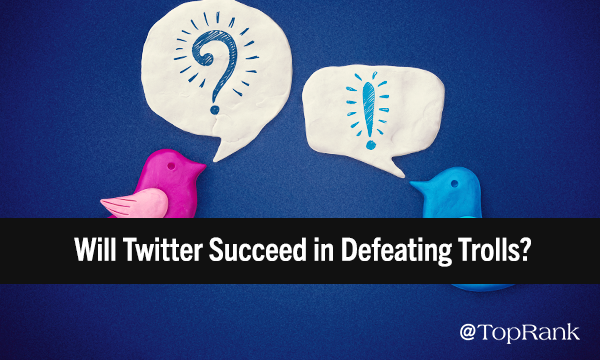Teeming with Trolls
In May, Twitter released a statement acknowledging the existence of “troll-like behaviors that distort and detract from the public conversation on Twitter, particularly in communal areas like conversations and search.”Purging and Learning
Most conspicuous among these initiatives has been “The Great Twitter Purge,” a systematic effort to sweep out fake and suspicious accounts. Data obtained by the Washington Post showed that more than 70 million accounts were suspended in May and June alone, at the expense of the company’s stock. (Incidentally, the aforementioned Britney Spears was among the hardest-hit by the purge in terms of lost followers, and plenty of high-profile marketers saw their numbers drop as well, though the industry has generally approved of these actions.) More recently, Twitter announced partnerships on academic projects addressing two primary areas of concern:- Echo chambers, and the ramifications of algorithms that filter content representing like-minded perspectives. A group led by Leiden University’s Dr. Rebekah Tromble “will analyze the echo chamber effect, and provide options on how to limit such impacts,” per Social Media Today.
- The effects of exposure to a diverse array of viewpoints and backgrounds. This can be the natural sacrifice in the “echo chamber” dynamic referenced above — how costly is it? “Evidence from social psychology has shown how communication between people from different backgrounds is one of the best ways to decrease prejudice and discrimination,” says Oxford’s Miles Hewstone, who will be among those spearheading the study.
What Twitter’s Moves Mean for Marketers
Twitter has always been a somewhat tough nut to crack for marketers, and the network’s diminishing reputation in the face of these controversial issues appears to be causing some businesses to further back off. The 2018 Social Media Marketing Industry Report from Social Media Examiner showed Twitter losing ground, with 62% of marketers using it in their strategies compared to 68% in 2017. Meanwhile, the latest Sprout Social Index finds Twitter fourth on the list of most-used channels for ads at just 13%. While it’s pretty simple to incorporate as a social media marketing tactic — schedule those short-and-sweet messages and fire ‘em out — the visible impact isn’t always there. It’s not uncommon to see brands with tens of thousands of followers getting only a handful of likes and responses to most of their updates, and clicks can be hard to come by. When you’re pumping out tons of content and garnering minimal engagement, while also converting a relatively tiny fraction of users into buyers, it’s easy to see why many marketers haven’t found the juice to be worth the squeeze. But these latest maneuvers from Twitter seemingly will only help. If you saw your company’s following on the platform take a hit over the past few months during the purge, you’re not alone. But ultimately, it’s nice to have a little more confidence that you’re actually broadcasting to real people. As we’ve long been saying around here: quality trumps quantity. Initial data backs up this hypothesis: Twitter reported an 81% increase in ad engagement during Q2 2018 compared to Q1 as it implemented its cleansing procedure. TopRank Marketing Social Media Strategist Meg McDougall suggests that we’ll likely see a resulting rise in Twitter’s notoriously low CPMs, but advertisers will essentially be paying for the same number of eyeballs because fake accounts and their false impressions are being eliminated. While it’s not clear what fallout we’ll see as a result of these new exploratory research initiatives, the shift is bound to be positive for marketers. Any reduction in the “echo chamber” algorithm could potentially grow your exposure to wider and more diverse audiences. [bctt tweet="While it’s not clear what fallout we’ll see as a result of @Twitter's new exploratory research initiatives, the shift is bound to be positive for #marketers. - @NickNelson #SocialMediaMarketing" username="toprank"] If the net outcome of these efforts is that Twitter users (even if there are less of them) become more engaged and active on the platform, that’s obviously going to help with content traction, both organic and paid. “Any change that is made on social media in the interest of end users is ultimately valuable for marketers,” says McDougall. [bctt tweet="Any change that is made on #socialmedia in the interest of end users is ultimately valuable for marketers. - @megnificent_" username="toprank"] For a Twitter fanatic and marketer like myself, these developments are roundly encouraging. What’s your take? Share your thoughts in the comments section below. Want to learn more about the present state of Twitter and social media marketing at large? Check out these posts from the TopRank Marketing blog:- 7 Examples of Brands Mastering Twitter for Social Customer Care
- From Messenger Bots to the Growth of ‘Gram, Social Media Examiner’s Annual Report Reveals Trends to Watch
- Will More Tweet Space Equal More Value for Your Twitter Audience?
- Best Practices for Choosing Effective and Captivating Social Media Visuals
- What All Marketers Can Learn from Fast Food Giants Crushing Twitter
The post Will Twitter Succeed in Defeating Trolls? The Stakes for Marketers appeared first on Online Marketing Blog - TopRank®.
from Online Marketing Blog – TopRank® https://ift.tt/2OMmbaP
via IFTTT

